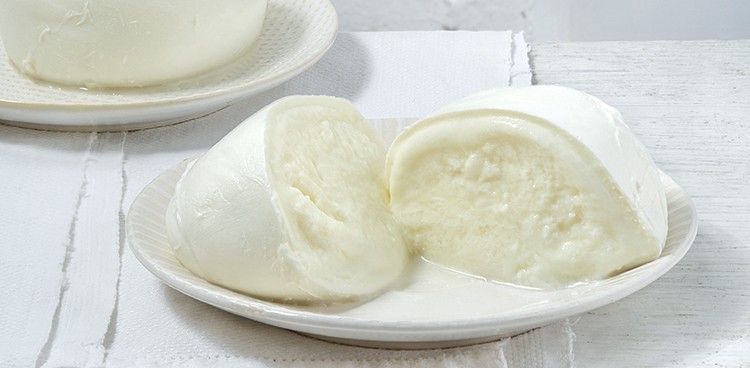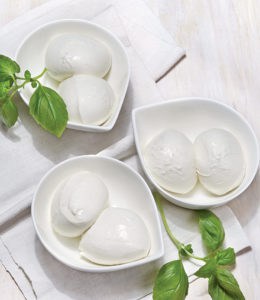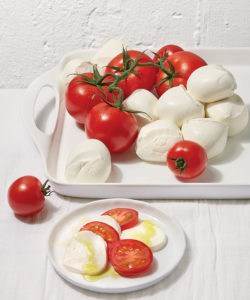
Luca Mignogna has been in his Massachusetts creamery for almost 12 hours, but the most important part of his day is yet to begin. At 3 a.m., the Italian native and owner of Wolf Meadow Farm added cultures to a vat of fresh cow’s milk, waited for it to slowly acidify, and then tipped in rennet to help it coagulate. After cutting the curd into small pieces and allowing them to form together into a flat slab, he sliced that slab into small strips—firm, chewy masses with a bit of a rubbery squeak—as his apprentice heated a pot of water. Now, as Mignogna slowly pours boiling water on those strips, they melt and fuse together.
With a long wooden spoon in one hand and a wooden bowl in the other, he gathers the mass of curd together into a ball and turns it over. It becomes slick and shiny—ribbony like chewing gum, yet slow-flowing like lava. Grabbing the spoon with two hands, he slips it under the mass and pulls it up, a veil of curds stretching out and becoming thinner and more elastic with each tug. Again and again he pulls the spoon up as high as possible, the curd stretched out and attached, to prove that it won’t break.
“See this? I could stretch this from here,” he says, pointing to the front door, “to there,” gesturing to the back door.
Stretching Science

Calabro Cheese Corp. Ovoline
During this phase of mozzarella-making at Wolf Meadow Farm, a room that’s usually bustling with boisterous Italian chitchat falls silent with concentration. If the stretching goes well, Mignogna’s cheese will be supple and moist. But a slight misstep—one degree too hot or a second too long—can cause irreversible damage: The curd’s fat might leach out, or its proteins might become brittle, resulting in a cork-like final texture. These are the most important few moments in the process.
Before they are stretched, mozzarella curds are similar in structure to curds that produce other styles of cheese: chunks of coagulated milk containing networks of protein strands—kind of like fishnets—with fat globules and whey inside. But when mozzarella curds are placed in hot water, something interesting happens. If they have the right chemistry—a specific pH and mineral content—their fat droplets liquefy and the casein protein network collapses. As Mignogna pulls, strands that once formed that protein network coalesce, forming thicker bundles oriented in the direction of the pulling, while fat and whey that were once distributed in small crevices now accumulate in long, open columns.
Post-stretching, Mignogna tears off fist-sized balls from that giant kneaded mass and places them in cool water to firm up. Later they’ll be packaged in brine for sale. The unique curd structure of these cooled orbs is easy to observe when you pull off a piece, explains University of Vermont food scientist Paul Kindstedt, who has studied the stretching process closely.
“Pull down at a right angle, and it just peels,” he says. The new columns of fat and moisture created during stretching become weak points where unfurling happens. When heated again during cooking, those columns become supple and flexible once more, and pulling results in endlessly spooling strands: the curd attached to Mignogna’s spoon or stubborn threads that extend when you pull a pizza slice away from the pie. “That’s the trick of mozzarella,” Kindstedt adds.
Transcontinental Tradition

Maplebrook Farm Bocconcini
Stretching isn’t unique to mozzarella; it’s a technique that characterizes an entire genre of cheeses. These pasta filata (“spun paste”) styles are native to the northern Mediterranean—Italy, Greece, and Eastern Europe, including the Balkans and Turkey. Many are firm and aged: Italian caciocavallo, Greek kasseri, Balkan kashkaval.
Mozzarella is a regional take on that pasta filata style—a uniquely “fresh, juicy type,” Kindstedt says, which originated in southern Italy near Campania. As early as the 12th century, pilgrims to the San Lorenzo monastery in Capua described monks dispensing a fresh cheese made from the milk of water buffalo that lived in the region’s hot, swampy marshlands.
These monks likely knew what Kindstedt explains now: The protein-, calcium-, and fat-rich milk from water buffalo, particularly its ratio of fat to casein protein, lends curds an exceptional ability to trap moisture. “Buffalo’s milk is beautifully designed . . . to produce a very high-moisture, succulent pasta filata cheese,” he says. Time-honored techniques—such as pulling with a wooden spoon in hot water and packaging the finished cheese in water or brine—help the stretched curd maintain as much moisture as possible.
Buffalo’s milk is not the only suitable base for mozzarella. Makers in southern Italy perfected a bovine version over time called fior di latte. Southern Italians may have left buffalos behind when they immigrated in droves to the United States in the 19th century, but they did bring their culture’s cheese devotion. Finding plenty of cow’s milk available, these new Americans churned out fresh, hand-stretched balls of fior di latte daily, just as they had back home—and they called it mozzarella. As families passed on traditions through generations, fresh mozzarella remained a staple in Italian communities.
“Mozzarella was something that you bought from the corner latticini, a little store in an Italian neighborhood, not at the supermarket,” says Johann Englert, co-founder of Maplebrook Farm in Bennington, Vt.
The proliferation of fast food following World War II resulted in the exploding popularity of pizza, prompting industrial producers to develop a lower-moisture, part-skim version of mozzarella that had a firmer texture for easier shredding and a longer shelf life. By the 1980s more than three-quarters of all so-called “mozzarella” produced in the US was used on pizza, allowing it to surpass cheddar as America’s most-consumed cheese by 2001.
Despite mozzarella’s ubiquity as “pizza cheese,” it was rare to find fresh, Italian-style versions outside of specialty shops. That’s why Englert teamed up with third-generation cheesemaker Mike Scheps to establish Maplebrook Farm in 2003. Since then she’s watched the market evolve, from a surge in demand for fresh mozzarella a decade ago to the growing variety of shapes, sizes, and flavors on grocery shelves. Now, Englert believes, “it’s the most popular cheese you can find.”
Forging Forward
Meanwhile in Glenmore, Wis., two arms dig into a mass of hot curd and knead it in and out, in and out, over and over again. Unlike Mignogna’s limbs guiding a wooden spoon, these are silver rods of a buzzing machine, one crafted in Italy to mimic the pulling, rolling-over, and stretching done by a master mozzarella maker. Without its help, churning out thousands of fresh mozzarella balls each day would be close to impossible for BelGioioso Cheese. “We would require an army,” says Gianni Toffolon, the award-winning company’s first Master Cheesemaker.

BelGioioso Cheese Inc. Pearls
The Italian native is quick to note that the machine does not work alone. “Our people—they are the artisans who decide if the curd has the right temperature, the right pH, the right moisture,” he says. Producers such as BelGioioso represent a more recent development in the mozzarella industry: Larger companies are embracing technology that makes production safer and more efficient, while still turning out fresh, high-quality cheese.
As Americans have tuned in to the wonders of fresh mozzarella, inevitably they’ve also discovered the original: Italian Mozzarella di Bufala Campana, now protected with a DOP. “Everyone seems to be importing it from Italy,” says Elliot Angeloni, a third-generation cheesemaker at Calabro Cheese Corp. in Connecticut. Angeloni is one producer on this side of the globe getting into the buffalo’s milk game; he’s been experimenting with his own version for a year now. Perhaps the biggest obstacle is sourcing raw ingredients: Unable to find a reliable domestic source, Angeloni imports tanks of buffalo’s milk from Italy.
South of the border, though, is a country with an abundance of that coveted milk. About eight years ago, a group of farmers raising male buffalo as draft animals in Colombia anticipated growing demand stateside. After traveling to Italy to see how buffalo mozzarella was made, Alejandro Gomez Torres and his team at BUF Creamery began milking females back home. Not only are Colombian buffalo a different breed than their Italian counterparts (a genetic melting pot of strains from Trinidad and Tobago, Brazil, and India) but the warm, humid Colombian climate yields different flora, resulting in different fat and protein levels in the milk and necessitating serious experimentation—what Torres describes as the “tropicalizing” of the traditional Italian recipe.
Back at Wolf Meadow, Mignogna doesn’t expect that his mozzarella will grace the shelves of supermarkets across America. Instead he’s decided to model his business after those in his home region of Italy—Molise—where more than 50 small fior di latte–making dairies are found in a 25-mile radius. When she visited Molise, Wolf Meadow’s director of operations Christina Barbieri was struck by customers’ loyalty. “Little old ladies—they would say, ‘I go here for the mozzarella, there for the ricotta, and there for the caciocavallo,’” she recalls.
Few Americans have a daily mozzarella shopping habit, but as more and more locals frequent the dairy and its Boston Public Market stand to taste what Mignogna and Barbieri are offering, Wolf Meadow is developing a regular following.
And perhaps that’s how it should be. Mozzarella is not like other artisan cheeses enjoyed only on special occasions or on cheese plates. It has myriad partners beyond summer tomatoes or pizza. Fresh, milky, and mild, it’s both an indulgence and daily sustenance, with an uncanny ability to elevate almost every meal. Perhaps that’s why, as Mignogna explains, Italians don’t really describe mozzarella as a cheese. “Mozzarella is not formaggio,” he says. “Mozzarella is mozzarella.”
How to Taste Mozzarella
Many of the tastes and aromas we find in cheese are caused by the breakdown of fats and proteins during aging. Mozzarella, however, is best enjoyed fresh, so its qualities are milder and subtler—an embodiment of the “pristine flavor of the milk,” says Jill Giacomini Basch, co-owner of California-based Point Reyes Farmstead Cheese Co. When comparing mozzarellas, seek these important attributes:
In terms of APPEARANCE, examine the level of shininess—an Italian adage says that you should be able to see your reflection in fresh mozzarella’s sheen. Also consider color, which might range from the creamy, buttery hue of grass-fed cow’s milk mozzarella to the porcelain-white of buffalo versions. (Because buffalo convert yellowy carotenoids into vitamin A, the pigments don’t show up in the milk as they do in cow’s milk.)
If the stretching process goes awry, mozzarella’s TEXTURE can be tough and rubbery or, alternatively, too elastic. The perfect ball will be moist, soft, and slightly springy; cuts made into it will be clean. When melted, the cheese should be fibrous, stretchy, and a bit chewier.
On the nose, mozzarella’s AROMA should be like a glass of fresh milk. “You get some of those cream notes, some brightness, a little citrus aroma,” Basch says. Some mozzarellas are slow-cultured with bacteria while others are acidified directly using citric acid or vinegar; the slow-cultured versions will have “a very nice lactic note,” says University of Vermont food scientist Paul Kindstedt.
TASTE should be clean and bright, not muddied with other flavors. Sourness and acidity might indicate the use of vinegar or citric acid during production. Salt can range from barely detectable to brackish, depending on each maker’s recipe and techniques. Less-salty versions lend themselves well to cooking.
Mozz from Other Milks?

The Mozzarella Company Capriella
While several pasta filata cheeses in Turkey and the Middle East are made from sheep’s and/or goat’s milk, they tend to be drier and firmer than fresh mozzarella. Thanks to a higher protein concentration, these milks don’t have the same ability to hold moisture in the curd seen in cow’s milk and, especially, buffalo’s milk, says Paul Kindstedt. Until recently, attempts at making fresh mozzarella with other milks usually resulted in lower-moisture versions, akin to pizza cheese.
However, in 2015 Italian food scientist Michele Faccia and colleagues published a paper outlining new recipes they developed for fresh goat’s milk and sheep’s milk versions. While the curd was trickier to stretch, varying acidification methods as well as the temperature and rennet dose during coagulation resulted in mozzarella comparable to cow’s milk versions. These mozzarellas also displayed new aromas: hints of almond in the goat’s milk version and walnut in the sheep’s milk. For farmers with small ruminants, this might be a way to capitalize on fresh cheese’s popularity. “There’s a major effort in Italy to develop this mozzarella because the sheep’s milk and goat’s milk producers are always looking for new, value-added ways to make a living,” Kindstedt says.
Tasting Notes
MOZZARELLA
Point Reyes Farmstead Cheese Company
Point Reyes Station, Calif.
Pasteurized cow’s milk
Luscious and glistening with a solid-yet-supple paste, this orb exhibits clean flavor without a trace of salt—like drinking a glass of fresh farmstead milk.
BOCCONCINI
Maplebrook Farm
Bennington, Vt.
Pasteurized cow’s milk
Beneath the surface, these outwardly smooth, bite-size balls yield a fairly firm yet moist and fibrous curd. Mild aromas hint at salt and bread dough, while a skim-milk flavor with a touch of bitterness grows slowly on the palate.
CAPRIELLA
The Mozzarella Company
Dallas
Pasteurized cow’s and goat’s milk
The only part-goat’s milk mozzarella we could find has a firmer, somewhat sticky texture with tangy yogurt aromas and a whisper of butter.
PEARLS
BelGioioso Cheese Inc.
Glenmore, Wis.
Pasteurized cow’s milk
These cute little nuggets are bright and milky white and taste slightly salty with a nice balance of bitter and sweet. Like chewing on whole milk—in a good way.

BUF Creamery Ciliegine
CILIEGINE
BUF Creamery
El Rosal, Colombia
Pasteurized buffalo’s milk
Smelling of warm whole milk, these cherry-sized, South American morsels boast unique texture—a dense center surrounded by a pillowy outer layer—with creamy flavor and grassy background notes.
OVOLINE
Calabro Cheese Corp.
East Haven, Conn.
Pasteurized cow’s milk
These eggs have an absolutely clean scent with a shot of salt upfront followed by refreshing notes of sweet cream.
MOZZARELLA
Wolf Meadow Farm
Amesbury, Mass.
Pasteurized cow’s milk
Pull apart a ball of this ultra-fresh, salty mozzarella to witness the wonders of hand stretching: It’ll unravel into small strings that squeak slightly and exude milkiness on the palate.
MOZZARELLA DI BUFALA CAMPANA DOP
Casa Madaio
Eboli, Italy
Pasteurized buffalo’s milk
Cut into this DOP-certified bufala from the Salerno region of Italy, and its insides will ooze into a puddle. The aroma is doughy with hints of grass and musk, while the flavor is bright and evolves from an initial tang to a long, salty finish.



